Anglo-Spanish War (1585–1604)
| Anglo-Spanish War | |||||||
|---|---|---|---|---|---|---|---|
 The Somerset House Conference between diplomats of England (right) and Spain (left) (painting) | |||||||
| |||||||
| Belligerents | |||||||
|
|
| ||||||
| Commanders and leaders | |||||||
The Anglo-Spanish War (1585–1604) was an intermittent conflict between the kingdoms of Spain and England that was never formally declared. The war was punctuated by widely separated battles, and began with England's military expedition in 1585 to the Netherlands under the command of the Earl of Leicester in support of the resistance of the States General to Spanish Habsburg rule.
The English enjoyed some victories at Cádiz in 1587, and saw the Spanish Armada retreat in 1588, but then suffered severe defeats of the English Armada in 1589 and the Drake–Hawkins and Essex–Raleigh expeditions in 1595 and 1597 respectively. Two further Spanish armadas were sent in 1596 and 1597 but were frustrated in their objectives mainly because of adverse weather and poor planning.
The war became deadlocked around the turn of the 17th century during campaigns in Brittany and Ireland. It was brought to an end with the Treaty of London, negotiated in 1604 between representatives of the new King of Spain, Philip III, and the new King of England, James I. England and Spain agreed to cease their military interventions in the Spanish Netherlands and Ireland, respectively, and the English ended high seas privateering.
Causes
In the 1560s, Philip II of Spain was faced with increasing religious disturbances as Protestantism gained adherents in his domains in the Low Countries. As a defender of the Catholic Church, he sought to suppress the rising Protestant heresy in his territories, which eventually exploded into open rebellion in 1566. Meanwhile, relations with the regime of Elizabeth I of England continued to deteriorate, following her restoration of royal supremacy over the Church of England through the Act of Supremacy in 1559; first instituted by her father Henry VIII and rescinded by her sister Mary I. The Act was considered by Catholics as an usurpation of papal authority. Calls by leading English Protestants to support the Protestant Dutch rebels against Philip increased tensions further as did the Catholic-Protestant disturbances in France, which saw both sides supporting the opposing French factions.
Complicating matters were commercial disputes. The activities of English sailors, begun by Sir John Hawkins in 1562, gained the tacit support of Elizabeth, even though the Spanish government complained that Hawkins's trade with their colonies in the West Indies constituted smuggling. In September 1568, a slaving expedition led by Hawkins and Sir Francis Drake was surprised by the Spanish, and several ships were captured or sunk at the Battle of San Juan de Ulúa near Veracruz, Mexico. This engagement soured Anglo-Spanish relations and in the following year the English detained several treasure ships sent by the Spanish to supply their army in the Netherlands. Drake and Hawkins intensified their privateering as a way to break the Spanish monopoly on Atlantic trade.
English support was provided to Prior of Crato in his struggle with Philip II for the Portuguese throne. Philip began to support the Catholic rebellion in Ireland against Elizabeth's religious reforms.
In 1584, Philip signed the Treaty of Joinville with the Catholic League of France to stop the rise of Protestantism in France. In 1585, Elizabeth signed the Treaty of Nonsuch with the Dutch rebels, agreeing to provide them with men, horses, and subsidies. In return the Dutch handed over four Cautionary Towns which were garrisoned by English troops. Philip took this to be an open declaration of war against his rule in the Netherlands.
Outbreak
The Anglo-Spanish War broke out in 1585, following the seizure of English merchant ships in Spanish harbors. In response the English privy council immediately authorised a campaign against the Spanish fishing industry in Newfoundland and off the Grand Banks.[2] The campaign was a huge success, and subsequently led to England's first sustained activity in the Americas.[3] In August, England joined the Eighty Years' War on the side of the Dutch Protestant United Provinces, who had declared their independence from Spain. Drake sailed for the West Indies and sacked Santo Domingo, captured Cartagena de Indias, and St. Augustine in Florida. Early in October the English landed in Galicia and sacked Vigo and Baiona.
Philip II planned an invasion of England, but in April 1587 his preparations suffered a setback when Drake burned 37 Spanish ships in harbour at Cádiz. In the same year, the execution of Mary, Queen of Scots on 8 February outraged Catholics in Europe, and her claim on the English throne passed (by her own deed of will) to Philip. On 29 July, he obtained Papal authority to overthrow Elizabeth, who had been excommunicated by Pope Pius V, and place whomever he chose on the throne of England.
Invasion
Spanish Armada

In retaliation for the execution of Mary, Philip vowed to invade England to place a Catholic monarch on its throne. He assembled a fleet of about 130 ships, containing 8,000 soldiers and 18,000 sailors. To finance this endeavour, Pope Sixtus V had permitted Philip to collect crusade taxes. Sixtus had promised a further subsidy to the Spanish should they reach English soil.[4]
On 28 May 1588, the Armada set sail for the Netherlands, where it was to pick up additional troops for the invasion of England. However, the English navy inflicted a defeat on the Armada in the Battle of Gravelines before this could be accomplished, and forced the Armada to sail northward. It sailed around Scotland, where it suffered severe damage and loss of life from stormy weather.
The defeat of the Armada provided valuable seafaring experience for English oceanic mariners. While the English were able to persist in their privateering against the Spanish and continue sending troops to assist Philip II's enemies in the Netherlands and France, these efforts brought few tangible rewards.[5] One of the most important effects of the event was that the Armada's failure was seen as a sign that God supported the Protestant Reformation in England. One of the medals struck to celebrate the English victory bore the Latin/Hebrew inscription Flavit יהוה et Dissipati Sunt (literally: "Yahweh blew and they were scattered"; traditionally translated more freely as: "He blew with His winds, and they were scattered".)
English Armada
An "English Armada" under the command of Sir Francis Drake and Sir John Norreys was dispatched in 1589 to torch the Spanish Atlantic navy, which was refitting in Santander, Corunna and San Sebastián in northern Spain. It was also intended to capture the incoming Spanish treasure fleet and expel the Spanish from Portugal – ruled by Philip since 1580 – in favour of the Prior of Crato. The English Armada was arguably misconceived and ended overall in failure. Had the expedition succeeded in its objectives, England may have threatened Spain's existence, and could have demanded that all of Spain's territory in the Americas be ceded in exchange for peace. Some merchant ships were captured at Corunna but when the English force, while waiting for a fair wind, pressed its attack on the citadel, they were repulsed and a number of English ships were captured by Spanish naval forces. Owing to poor organisation and lack of co-ordination with the Portuguese and Spanish reinforcements, the invading force also failed to take Lisbon. Sickness then struck the expedition, and finally a portion of the fleet led by Drake towards the Azores was scattered in a storm. In the end, Elizabeth sustained a severe loss to her treasury.
Later war
In this period of respite, the Spanish were able to refit and retool their navy, partly along English lines. The pride of the fleet were named The Twelve Apostles – twelve massive new galleons – and the navy proved itself to be far more effective than it had been before 1588. A sophisticated convoy system and improved intelligence networks frustrated and broke up the English privateering on the Spanish treasure fleet during the 1590s. This was best demonstrated in the failures of expeditions by Sir Martin Frobisher, John Hawkins and the Earl of Cumberland in the early part of the decade, as well as in the repulse of the squadron that was led by Effingham in 1591 near the Azores, who had intended to ambush the treasure fleet. It was in this battle that the Spanish captured the English flagship, the Revenge, after a stubborn resistance by its captain, Sir Richard Grenville. Throughout the 1590s, enormous convoy escorts enabled the Spanish to ship three times as much silver as in the previous decade.

In 1590, the Spanish landed a considerable force in Brittany to assist the French Catholic League, expelling the English and Huguenot forces from the area. However, Protestant Anglo-French forces retained Brest after the capture of Fort Crozon.
Both Drake and Hawkins died of disease during the disastrous 1595–96 expedition against Puerto Rico, Panama, and other targets in the Spanish Main, a severe setback in which the English suffered heavy losses in soldiers and ships. In 1595, a Spanish force, under Don Carlos de Amésquita, raided Penzance and several surrounding villages.
In 1596 an Anglo-Dutch expedition under Elizabeth's young favourite, the Earl of Essex, sacked Cádiz, causing significant loss to the Spanish fleet, leaving the city in ruins and delaying a projected descent on England. The allies were unable to capture the treasure, as the Spanish commander had time to torch the treasure ships in port, sending the treasure to the bottom of the harbour, from where it was later recovered. Despite its failure to capture the treasure fleet, the sack of Cadiz was celebrated as a national triumph comparable to the victory over the Spanish Armada, and for a time Essex's prestige rivalled Elizabeth's own.[6]
Triple Alliance and Nine Years' War

Normandy added a new front in the war and the threat of another invasion attempt across the channel. With the signing of the Triple Alliance in 1596 between France, England and the Dutch, Elizabeth sent a further 2,000 troops to France after the Spanish took Calais. Further battles continued until 1598, when Henry IV's conversion to Catholicism won him widespread French support for his claim to the throne; the French civil war had turned against the hardliners of the Catholic League and France and Spain signed the Peace of Vervins, ending the last of the Wars of Religion and Spanish intervention with it.
The English suffered defeat in the Islands Voyage in 1597, one of the last major fleet actions of the war. In response to Protestant privateering against their merchantmen, the Spanish monarchy struck back with the Dunkirkers, who took a heavy toll of Protestant shipping.
In 1594, the Nine Years' War in Ireland had begun, when Ulster lords Hugh O'Neill and Red Hugh O'Donnell rose up against English rule with fitful Spanish support, mirroring the English support of the Dutch rebellion. While English forces were containing the rebels in Ireland at great cost in men, general suffering and finance, the Spanish attempted two further armadas, in 1596 and 1597: the first was shattered in a storm off northern Spain, and the second was frustrated by adverse weather as it approached the English coast. King Philip II died in 1598, and his successor Philip III continued the war but was less determined.
At the end of 1601, a final armada was sent north, this time a limited expedition intended to land troops in southern Ireland to assist the rebels. The Spanish entered the town of Kinsale with 3,000 troops and were immediately besieged by the English. In time, their Irish allies arrived to surround the besieging force but the lack of communication with the rebels led to an English victory at the Battle of Kinsale. Rather than attempt to hold Kinsale as a base to harry English shipping, the Spanish accepted terms of surrender and returned home, while the Irish rebels hung on, surrendering in 1603, just after Elizabeth died.
The new king of England, James I, was the Protestant son and successor to the Catholic Mary, Queen of Scots, whose execution had been a proximate cause of the war. James regarded himself as the peacemaker of Europe, and the ultimate aim of his idealistic foreign policy was the reunion of Christendom.[7] Therefore, when James came to the English throne, his first order of business was to negotiate a peace with Philip III of Spain.
Treaty
The Treaty of London (1604) restored the status quo ante bellum, and the terms of the treaty were favourable both to Spain and England.[1][8] For Spain the treaty secured her position as a leading power in the world.[9][10] Spain's upgrading of the convoy system had allowed it to defend its treasure fleets and retain its New World colonies. For England the treaty made sure the Protestant reformation there had been protected and James and his ministers refused the Spanish demand for Catholic toleration in England. English support for the Dutch rebellion against the Spanish king, the original cause of the war, was ended but a complete abandonment of the Dutch cause was not promised.[11] The English held cautionary towns in Holland on the other hand were not surrendered despite Spanish demands.[12] The sieges of Ostend and Sluis were allowed to continue until the end of those respective campaigns.[13] English trade with the Spanish Netherlands (notably the city of Antwerp) and the Iberian peninsula was restored. While the nascent illegal trade with the Spanish colonies was brought to an end there was deadlock over English demands for the right to trade in the East & West Indies which Spain adamantly opposed. Eventually the complications resulted in the treaty avoiding any mention of the matter.[11] The war had also diverted Tudor colonial efforts and effective English settlement in North America was delayed until 1607. The establishment of the East India Company in 1600 however was significant for the growth of England (and later Great Britain) as a colonial power - a factory had already been established in Banten in the East Indies in 1602.[14] English privateering had devastated the Spanish private merchant marine and Spanish commerce would be increasingly carried on Dutch and English ships.[1]
As a result of the defeat at Kinsale in 1602 a treaty had been concluded the previous year between James I and the Irish rebels. In the subsequent London treaty Spain pledged not to support the rebels.
See also
Notes
- 1 2 3 Hiram Morgan, ‘Teaching the Armada: An Introduction to the Anglo-Spanish War, 1585-1604’, History Ireland, Vol. 14, No. 5 (Sep.–Oct., 2006), p. 43.
- ↑ Bicheno p 180
- ↑ Karen Ordahl Kupperman, The Jamestown Project
- ↑
 Pollen, John Hungerford (1907). "Spanish Armada". In Herbermann, Charles. Catholic Encyclopedia. 1. New York: Robert Appleton Company."Pope Sixtus V agreed to renew the excommunication of the Queen, and to grant a large subsidy to the Armada, but, knowing the slowness of Spain, would give nothing till the expedition should actually land in England. In this way he was saved his million crowns, and spared the reproach of having taken futile proceedings against the heretic queen."
Pollen, John Hungerford (1907). "Spanish Armada". In Herbermann, Charles. Catholic Encyclopedia. 1. New York: Robert Appleton Company."Pope Sixtus V agreed to renew the excommunication of the Queen, and to grant a large subsidy to the Armada, but, knowing the slowness of Spain, would give nothing till the expedition should actually land in England. In this way he was saved his million crowns, and spared the reproach of having taken futile proceedings against the heretic queen." - ↑ Richard Holmes 2001, p. 858: "The 1588 campaign was a major English propaganda victory, but in strategic terms it was essentially indecisive."
- ↑ David Starkey, Elizabeth (Channel 4, 1999), Episode 4, 'Gloriana'.
- ↑ W. B. Patterson, King James VI and I and the Reunion of Christendom (New York: Cambridge University Press, 1998).
- ↑ Paul Allen, Philip III and the Pax Hispanica, 1598-1621 (New Haven, 2000)
- ↑ The Pirates' Pact: The Secret Alliances Between History's Most Notorious Buccaneers and Colonial America. McGraw-Hill Professional, 2008, p29. ISBN 0-07-147476-5
- ↑ Channing, Edward: A history of the United States. Octagon Books, 1977, v. 1, p158. ISBN 0-374-91414-1
- 1 2 Hammer, Paul E. J (2003). Elizabeth's Wars: War, Government and Society in Tudor England, 1544-1604. Palgrave Macmillan. pp. 234–35. ISBN 9781137173386.
- ↑ Fritze, Ronald H; Robison, William B (1996). Historical Dictionary of Stuart England, 1603-1689. Greenwood Publishing Group. p. 310. ISBN 9780313283918.
- ↑ Rowse, A. L (1973). The Expansion of Elizabethan England. Cardinal Books. p. 413. ISBN 978-0351180644.
- ↑ Chaudhuri, K. N (1965). The English East India Company: The Study of an Early Joint-stock Company 1600-1640. Taylor & Francis. p. 3. ISBN 9780415190763.
Further reading
- Charles Beem, The Foreign Relations of Elizabeth I (2011) excerpt and text search
- Bicheno, Hugh (2012). Elizabeth's Sea Dogs: How England's Mariners Became the Scourge of the Seas. Conway. ISBN 978-1844861743.
- Peter Earle The Last Fight of the Revenge (London, 2004) ISBN 0-413-77484-8
- Winston Graham The Spanish Armadas (reprint 2001) ISBN 0-14-139020-4
- Jonathan I. Israel. Conflicts of Empires: Spain, the Low Countries, and the Struggle for World Supremacy, 1585-1713 (1997) 420pp

